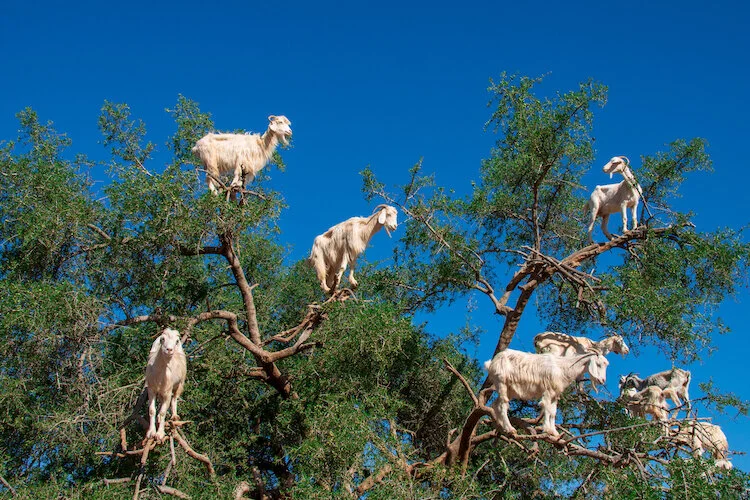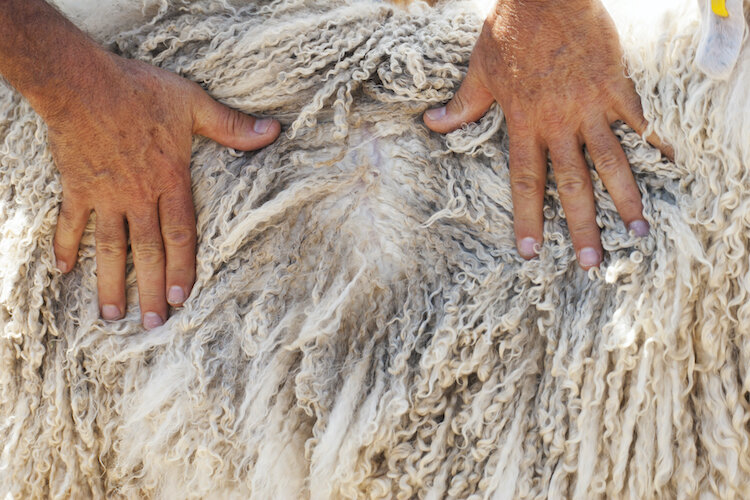We get milk, wool and meat from goats.
A baby goat is called a kid.
Its father is called a billy goat or buck.
Its mother is called a nanny goat or doe.
Goats can live on hills and in hot places.
Goats are mammals. There are about 600 different breeds, or kinds, of goats around the world.
Wild mountain goat and kid ©GettyImages
Some kinds of goats also live on farms. Goats were wild animals that were tamed thousands of years ago and became farm animals. There are still some kinds that are wild and live in mountains and other wild places.
Ibex are wild goats in the Alps. ©Getty
Goats can live in places that are very hot and dry or hilly, where it is hard for other farm animals to live.
Many breeds of goats are farmed for wool, milk and meat. Different breeds are farmed for different purposes: some produce plenty of milk, some grow wool that can be made into fine yarns and fabrics, while others are best farmed for meat. Goat meat is eaten in many countries.
What goats eat
There’s a saying that goats eat anything, but their digestive system is designed for plants, which means they are herbivores. Mostly they eat grass, but they also eat leaves. Farmers feed goats grass and hay because lots of that can be grown on the farm.
A kid suckling milk from its mother ©Getty Images
Goats have a special digestive system because plants are hard to digest. They chew food twice. After they swallow food it goes to a special stomach where it becomes a mush called cud, which then comes back into the animal's mouth to be chewed again.
Goats have horns and a beard, and each foot has a hoof. Horn shapes vary in different species or breeds. Some, such as the walliser and ibex, have very large horns. Some goats have fur that is all one colour, but some kinds have two or three colours.
Goats are intelligent and curious animals. The young are very playful.
Life Cycle
Kids ©Getty Images
A doe, or nanny goat, mates with a buck or billy goat. About 150 days later one or two babies are born. A baby goat is called a kid. Like all mammals, goat kids drink milk from their mother's udders for about 6 months before they can eat like an adult goat.
Meat
We get meat from goats in the same way we get meat from cows and sheep. A goat is very quickly killed without pain, and then a butcher cuts up the meat for us to buy and cook. In some countries, goat meat is commonly eaten, but in other countries only a few special butchers sell goat meat.
Fur
Angora goats have long curly fur ©Getty Images
Goats have wool covering their bodies. Some kinds have long hair, some short and some curly. The kind and colours of the coat is different for different kinds of goat.
The woolly covering keeps them warm in winter and cool in summer, it makes it hard for insects to bite their skin, and helps stop sticks and things like that from hurting their body. When the animal gets dirty, the dirt comes out of the fur easily.
Making cloth from a goat's wool
Angora goats have long, curly wool that is spun into soft yarn.©Getty
Goat's wool is cut twice a year. It is washed, dyed and spun into threads called yarn which can be knitted or woven into cloth.
The long curly wool of angora (say ang-gaw-ruh) goats is made into fluffy mohair yarn.
Pashmina goats in the Himalayas. ©Getty
The soft fur of the cashmere (say cash-me-uh) goats is made into fine soft wool yarn called cashmere. The finest cashmere wool is produced by the changra or pashmina goat, which lives in high mountains in Tibet, Nepal and China as well as Kashmir in India. The cold temperatures encourage the growth of an ultra-fine wool under the heavy outer layer of wool. In spring, the hair is naturally shed, and is collected. It is washed and spun into fine yarns to be knitted, or woven to make a fine, warm fabric that is cut and sewn into garments such as coats, suits, trousers, wraps and blankets.
The word cashmere comes from the name of part of India where the goats originated, Kashmir.
Milk
On a farm, goats are milked by machine. ©Getty
Some farms raise goats for dairy products. Many people who are allergic to cow's milk are able to drink goat's milk.
Goat's milk is also made into cheese, often known as chevre, which is the French word for goat. It is whiter than other cheeses and can be hard or soft.
A doe or nanny goat has udders that fill with milk each day. An udder is like a bag with teats hanging from under her tummy. The farmer or person who owns the goat attaches a machine to the udders. The machine squeezes the teats gently and the milk comes out into a container.
A goat being milked by hand. ©Getty
Sometimes a goat can be milked by hand: the farmer puts a bucket under the udders and squeezes the teats, and the milk comes out and fills the bucket.
Goat milk is also made into cheese. Goat cheese is often called chevre, which is the French word for cheese.
An unusual use for goats
In Morocco, goats play an important part in the argan oil industry which extracts the oil that comes from the seeds of the argan tree, found only in Morocco. The fruit can’t be eaten by humans, but goats love it. Goats eat the argan fruits that fall off the trees, but love them so much that they leap into the trees to eat them, moving easily from branch to branch. The seeds inside the fruit are very hard, so the goats swallow them whole. They can’t digest the hard seeds, so they pass out of the goats in their poo. The seeds are still whole but now they are soft enough to be crushed and the oil extracted. Argan oil is used in many cosmetic products.
A common sight in Morocco! ©Getty
It’s a good idea to get information from more than one source!
Read more about domestic goats
https://www.dkfindout.com/us/animals-and-nature/domesticated-animals/goats/
Read about wild goats
https://animalia.bio/wild-goat
Watch a video
https://www.youtube.com/watch?v=96LRW_knWMU
Read kidcyber pages about other kinds of farms and farm animals
Jamaican goat curry ©Getty













